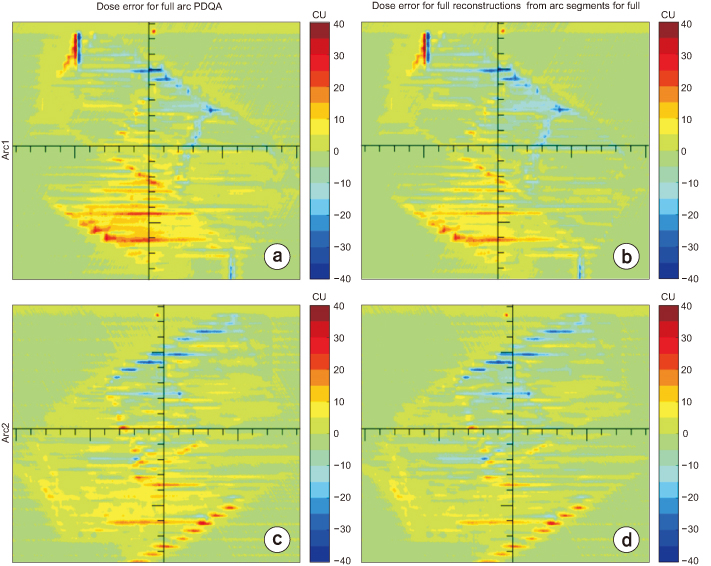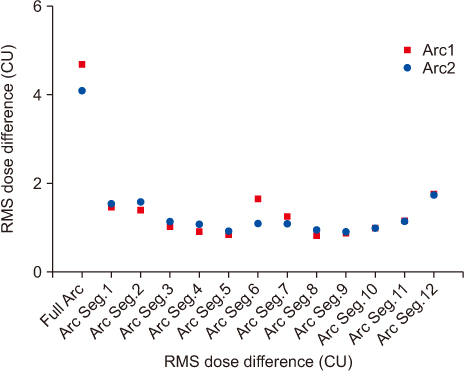Prog Med Phys.
2019 Dec;30(4):128-138. 10.14316/pmp.2019.30.4.128.
Segmental Analysis Trial of Volumetric Modulated Arc Therapy for Quality Assurance of Linear Accelerator
- Affiliations
-
- 1Department of Nuclear Engineering, Hanyang University, Seoul, Korea. dochokim@gmail.com
- 2Department of Radiation Oncology, Inha University Hospital, Incheon, Korea.
- 3Department of Radiation Oncology, Hanyang University Medical Center, Seoul, Korea.
- KMID: 2468174
- DOI: http://doi.org/10.14316/pmp.2019.30.4.128
Abstract
- PURPOSE
Segmental analysis of volumetric modulated arc therapy (VMAT) is not clinically used for compositional error source evaluation. Instead, dose verification is routinely used for plan-specific quality assurance (QA). While this approach identifies the resultant error, it does not specify which machine parameter was responsible for the error. In this research study, we adopted an approach for the segmental analysis of VMAT as a part of machine QA of linear accelerator (LINAC).
METHODS
Two portal dose QA plans were generated for VMAT QA: a) for full arc and b) for the arc, which was segmented in 12 subsegments. We investigated the multileaf collimator (MLC) position and dosimetric accuracy in the full and segmented arc delivery schemes. A MATLAB program was used to calculate the MLC position error from the data in the dynalog file. The Gamma passing rate (GPR) and the measured to planned dose difference (DD) in each pixel of the electronic portal imaging device was the measurement for dosimetric accuracy. The eclipse treatment planning system and a MATLAB program were used to calculate the dosimetric accuracy.
RESULTS
The maximum root-mean-square error of the MLC positions were <1 mm. The GPR was within the range of 98%-99.7% and was similar in both types of VMAT delivery. In general, the DD was <5 calibration units in both full arcs. A similar DD distribution was found for continuous arc and segmented arcs sums. Exceedingly high DD were not observed in any of the arc segment delivery schemes. The LINAC performance was acceptable regarding the execution of the VMAT QA plan.
CONCLUSIONS
The segmental analysis proposed in this study is expected to be useful for the prediction of the delivery of the VMAT in relation to the gantry angle. We thus recommend the use of segmental analysis of VMAT as part of the regular QA.
Keyword
Figure
Reference
-
1. Liu B, Adamson J, Rodrigues A, Zhou F, Yin FF, Wu Q. A novel technique for VMAT QA with EPID in cine mode on a Varian TrueBeam linac. Phys Med Biol. 2013; 58:6683–6700.
Article2. Woodruff HC, Fuangrod T, Rowshanfarzad P, McCurdy BM, Greer PB. Gantry-angle resolved VMAT pretreatment verification using EPID image prediction. Med Phys. 2013; 40:081715.
Article3. Mans A, Remeijer P, Olaciregui-Ruiz I, Wendling M, Sonke JJ, Mijnheer B, et al. 3D Dosimetric verification of volumetric-modulated arc therapy by portal dosimetry. Radiother Oncol. 2010; 94:181–187.
Article4. Podesta M, Nijsten SM, Persoon LC, Scheib SG, Baltes C, Verhaegen F. Time dependent pre-treatment EPID dosimetry for standard and FFF VMAT. Phys Med Biol. 2014; 59:4749–4768.
Article5. Fuangrod T, Greer PB, Woodruff HC, Simpson J, Bhatia S, Zwan B, et al. Investigation of a real-time EPID-based patient dose monitoring safety system using site-specific control limits. Radiat Oncol. 2016; 11:106.
Article6. Fuangrod T, Woodruff HC, van Uytven E, McCurdy BM, Kuncic Z, O'Connor DJ, et al. A system for EPID-based real-time treatment delivery verification during dynamic IMRT treatment. Med Phys. 2013; 40:091907.
Article7. Otto K. Volumetric modulated arc therapy: IMRT in a single gantry arc. Med Phys. 2008; 35:310–317.
Article8. Sievinen J, Ulmer W, Kaissl W. AAA Photon dose calculation model in eclipse™. CiteSeerX;Janne Sievien RAD #7170A.9. Varian Medical Systems. Eclipse photon and electron algorithms reference guide (P1008611-003-C). Palo Alto, CA: Varian Medical Systems;2015.10. Van Esch A, Depuydt T, Huyskens DP. The use of an aSibased EPID for routine absolute dosimetric pre-treatment verification of dynamic IMRT fields. Radiother Oncol. 2004; 71:223–234.
Article11. Varian Medical Systems. Portal dosimetry reference guide (P1015288-001-A). Palo Alto, CA: Varian Medical Systems;2015.12. Kim CH, Choi SH, Jeong JH, Lee C, Chung MS. HDRKMan: a whole-body voxel model based on high-resolution color slice images of a Korean adult male cadaver. Phys Med Biol. 2008; 53:4093–4106.
Article13. Rahman MM, Kim CH, Kim SH. Plan-class specific reference quality assurance for volumetric modulated arc therapy. J Radiat Prot Res. 2019; 44:32–42.
Article14. Varian Medical Systems. Dynalog file viewer reference guide (P/N 100013698-05). Palo Alto, CA: Varian Medical Systems;2011.15. Klein EE, Hanley J, Bayouth J, Yin FF, Simon W, Dresser S, et al. Task Group 142 report: quality assurance of medical accelerators. Med Phys. 2009; 36:4197–4212.16. Riddle WR, Pickens DR. Extracting data from a DICOM file. Med Phys. 2005; 32:1537–1541.
Article17. Agnew CE, Irvine DM, McGarry CK. Correlation of phantom-based and log file patient-specific QA with complexity scores for VMAT. J Appl Clin Med Phys. 2014; 15:204–216.
Article18. Code of practice for the quality assurance and control for volumetric modulated arc therapy. Netherlands Commission on Radiation Dosimetry (Subcommittee VMAT QA);2015. NCS Report 24.19. Miften M, Olch A, Mihailidis D, Moran J, Pawlicki T, Molineu A, et al. Tolerance limits and methodologies for IMRT measurement-based verification QA: recommendations of AAPM Task Group No. 218. Med Phys. 2018; 45:e53–e83.
Article20. Mayles WPM, Lake R, McKenzie A, Macaulay EM, Morgan HM, Jordan TJ, et al. Report 81. Physics aspects of quality control in radiotherapy. 2nd ed. York: Institute of Physics and Engineering in Medicine;2018.21. Alber M, Mijnheer B, Georg D. Guidelines for the verification of IMRT. Brussels: European Society for Therapeutic Radiology and Oncology;2008.22. Code of practice for the quality assurance and control for intensity modulated radiotherapy. Netherlands Commission on Radiation Dosimetry (Subcommittee VMAT QA);2013. NCS Report 22.23. Low DA, Moran JM, Dempsey JF, Dong L, Oldham M. Dosimetry tools and techniques for IMRT. Med Phys. 2011; 38:1313–1338.
Article24. International Commission. Prescribing, recording, and reporting photonbeam intensity-modulated radiation therapy (IMRT). J ICRU. 2010; 10.25. Ezzell GA, Burmeister JW, Dogan N, LoSasso TJ, Mechalakos JG, Mihailidis D, et al. IMRT commissioning: multiple institution planning and dosimetry comparisons, a report from AAPM Task Group 119. Med Phys. 2009; 36:5359–5373.
Article26. Ling CC, Zhang P, Archambault Y, Bocanek J, Tang G, Losasso T. Commissioning and quality assurance of RapidArc radiotherapy delivery system. Int J Radiat Oncol Biol Phys. 2008; 72:575–581.
Article27. Losasso T. IMRT delivery performance with a varian multileaf collimator. Int J Radiat Oncol Biol Phys. 2008; 71:1 Suppl. S85–S88.
Article28. Park JM, Wu HG, Kim JH, Carlson JN, Kim K. The effect of MLC speed and acceleration on the plan delivery accuracy of VMAT. Br J Radiol. 2015; 88:20140698.
Article29. Kerns JR, Childress N, Kry SF. A multi-institution evaluation of MLC log files and performance in IMRT delivery. Radiat Oncol. 2014; 9:176.
Article30. McGarry CK, Agnew CE, Hussein M, Tsang Y, Hounsell AR, Clark CH. The use of log file analysis within VMAT audits. Br J Radiol. 2016; 89:20150489.
Article31. Scaggion A, Negri A, Rossato MA, Roggio A, Simonato F, Bacco S, et al. Delivering RapidArc®: a comprehensive study on accuracy and long term stability. Phys Med. 2016; 32:866–873.
Article32. Song Y, Obcemea C, Mueller B, Mychalczak B. A systematic approach to patient specific QA for volumetric modulated arc therapy (VMAT). IFMBE Proc. 2013; 39:1872–1875.
Article33. Kosaka K, Tanooka M, Doi H, Inoue H, Tarutani K, Suzuki H, et al. Feasibility of estimating patient-specific dose verification results directly from linear accelerator log files in volumetric modulated arc therapy. Int J Med Phys Clin Eng Radiat. 2016; 5:317–328.
Article34. Kim JI, Choi CH, Wu HG, Kim JH, Kim K, Park JM. Correlation analysis between 2D and quasi-3D gamma evaluations for both intensity-modulated radiation therapy and volumetric modulated arc therapy. Oncotarget. 2017; 8:5449–5459.
Article35. Defoor DL, Vazquez-Quino LA, Mavroidis P, Papanikolaou N, Stathakis S. Anatomy-based, patient-specific VMAT QA using EPID or MLC log files. J Appl Clin Med Phys. 2015; 16:5283.
Article36. Rahman MM, Kim CH, Kim S. Daily based quality assurance of volumetric modulated arc therapy for the full session of treatment. J Korean Phys Soc. 2018; 73:990–1000.
Article37. Rahman MM, Kim CH, Kim S. Mid-term performance of clinical LINAC in volumetric modulated arc therapy. J Radiat Prot Res. 2019; 44:43–52.
Article38. Oliver M, Bush K, Zavgorodni S, Ansbacher W, Beckham WA. Understanding the impact of RapidArc therapy delivery errors for prostate cancer. J Appl Clin Med Phys. 2011; 12:3409.
Article39. Liang B, Liu B, Zhou F, Yin FF, Wu Q. Comparisons of volumetric modulated arc therapy (VMAT) quality assurance (QA) systems: sensitivity analysis to machine errors. Radiat Oncol. 2016; 11:146.
Article40. Cheong KH, Lee MY, Kang SK, Yoon JW, Park S, Hwang T, et al. Statistical quality control for volumetric modulated arc therapy (VMAT) delivery by using the machine's log data. J Korean Phys Soc. 2015; 67:63–70.
Article
- Full Text Links
- Actions
-
Cited
- CITED
-
- Close
- Share
- Similar articles
-
- A Comparison between Portal Dosimetry and Mobius3D Results for Patient-Specific Quality Assurance in Radiotherapy
- Feasibility Study of Mobius3D for Patient-Specific Quality Assurance in the Volumetric Modulated Arc Therapy
- Dosimetric Comparison of Noncoplanar and Coplanar Volumetric Modulated Arc Therapy Plans for Esophageal Cancer
- Suggestion for Comprehensive Quality Assurance of Medical Linear Accelerator in Korea
- Dosimetric Effect on Selectable Optimization Parameters of Volumatric Modulated Arc Therapy








